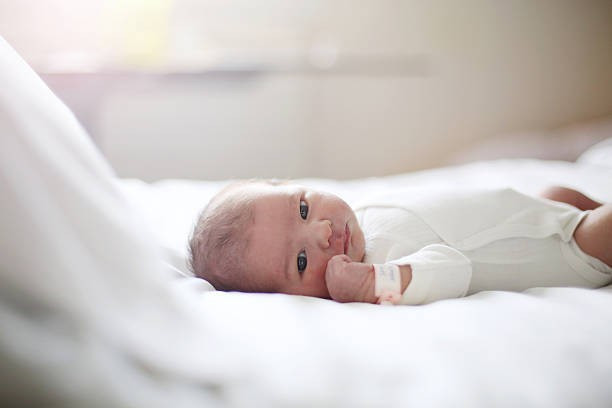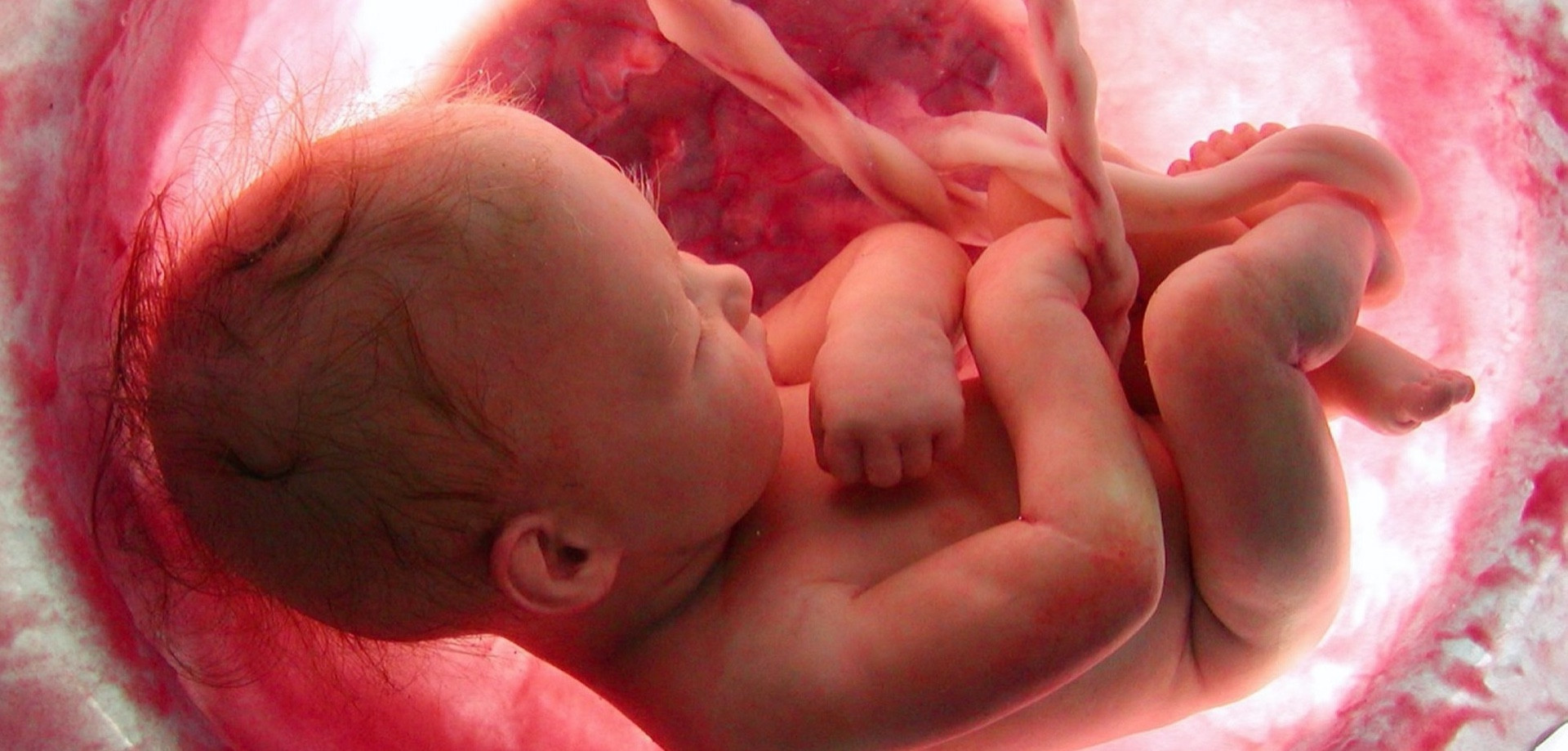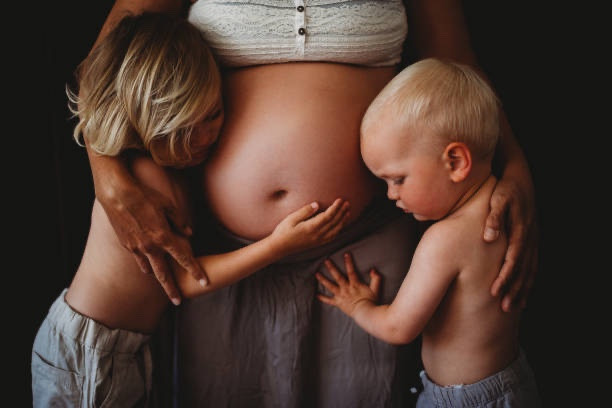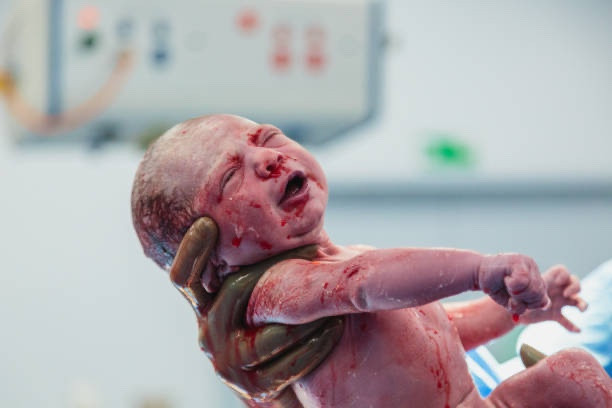PSALTER 46 Investment Services ™
The Baby Plan Programs
___________________________________________________________
____________________________________________________________
Breastfeeding Helps the Uterus Contract. During pregnancy, your uterus grows immensely, expanding from the size of a pear to filling almost the entire abdomen space. After delivery, your uterus goes through an involution process, which helps it return to its previous size. Oxytocin, a hormone that increases throughout pregnancy, helps drive this process. Your body secretes high amounts of oxytocin during labor to help deliver the baby and reduce bleeding.
Oxytocin increases breastfeeding, encourages uterine contractions, and reduces bleeding, helping the uterus return to its previous size. Studies have also shown that mothers who breastfeed generally have less blood loss after delivery and faster involution of the uterus.
Breastfeeding Makes Children Keener. Some studies suggest a difference in brain development between breastfed and formula-fed babies. This difference may be due to the physical intimacy, touch, and eye contact associated with breastfeeding. Studies indicate that breastfed babies have higher intelligence scores and are less likely to develop problems with behavior and learning. However, the most pronounced effects are seen in preterm babies with a higher risk of developmental issues. The research clearly shows that breastfeeding has a significant positive impact on long-term brain development.
Breastfeeding cuts the risks of disease. Breastfeeding has an impressive list of health benefits. It may reduce your baby's risk of many illnesses and conditions, including:
1.) Middle ear infections. Three or more months of exclusive breastfeeding may reduce the risk by 50%, while any breastfeeding may reduce it by 23%.
2.) Respiratory tract infections. Exclusive breastfeeding for more than 4- months reduces the risk of hospitalization for these infections by up to 72%.
3.) Colds and infections. Babies exclusively breastfed for six months may have up to a 65% lower risk of getting severe colds and ear or throat infections.
4.) Stomach infections. Breastfeeding is linked with a 70% decline in stomach infections, seen for up to 2 months after breastfeeding discontinues.
5.) Intestinal tissue damage. Feeding preterm babies breast milk is linked with around a 60% reduction in the incidence of necrotizing enterocolitis.
6.) Sudden infant death syndrome (SIDS). Breastfeeding is linked to a 60% reduced risk after one 1-month and a 40% reduced risk in the first year.
7.) Allergic diseases. Exclusive breastfeeding for at least 3–4 months is linked with a 30–47% reduced risk of asthma, atopic dermatitis, and eczema.
8.) Celiac disease. Breastfed babies at first gluten exposure have a 60% lower risk of developing celiac disease.
9.) Inflammatory bowel disease. Breastfed babies may be roughly 48% less likely to develop childhood inflammatory bowel disease.
10.) Diabetes. Breastfeeding for at least three months is linked to a reduced risk of type 1 diabetes (up to 40%) and type 2 diabetes (up to 42%).
11.) Childhood leukemia. Breastfeeding for six months or longer is linked with a 17–23% reduction in the risk of childhood leukemia.
To reduce the risk of many infections, it is good that you use breastfeeding to increase additional health benefits for your infant.
It's essential to be aware of the potential complications that can arise during and after childbirth. If you experience shaking or chills right after delivery, don't worry; it's a common reaction that can be easily managed with a warm blanket. Your healthcare provider will also be on hand to help you with any other issues that may arise, such as bleeding or hemorrhaging. In severe cases, surgery may be necessary to stop bleeding and prevent shock. It's essential to keep an eye on your bladder as well, as a full bladder can interfere with contractions and lead to complications.
Some pregnancies are considered high-risk due to potential complications that could affect the mother, baby, or both. If you are experiencing a high-risk pregnancy, it's vital to seek out specialized care from a healthcare provider who can help manage your condition and ensure the best possible outcome for you and your baby. Preparing a contingency plan in case natural childbirth is not an option is also a good idea. Remember, it's always better to be prepared and informed about your health and your baby's health.
Investing is one of the most important things you can do to build wealth. At PSALTER 46, we know investing isn’t only about asking what stocks to buy and how they fit into your overall financial plan. That’s why we have a wide range of investment options based on your goals that are options unmatched, including stocks, bonds, and exchange-traded funds (ETFs.)
Nathanael Ner
New York
Are you planning to have a child? If so, this would be the time to plan your newborn's birth precisely. It is the responsible thing to do besides taking daily prenatal vitamins, eating healthy, avoiding smoking, and drinking alcohol. There are other things that expectant moms and dads must take care of before the baby's arrival. It is time to start planning for the baby's financial security! Now that you are going to bring a newborn into this world. It would be best if you began to get serious about your forthcoming condition and the future of your family unit. Investing today can be your help tomorrow! You may have heard that raising a child costs a fortune. The first-year financial cost of your child following the birth will be, on average, $17,335.37, with an increase of 3.4% yearly after that. By the time your child becomes 18 years old, the cost of raising him or her will be, on average, $332,645.86.
When you are all excited with your enhanced feelings of emotions mixed with sensations of being a mom and thoughts of motherhood, many women do not take the time to consider a financial plan for the forthcoming child or check the insurance plan to understand what is covered in the policy concerning childbirth. People do not connect pregnancy with financial planning, and factoring in children early into a financial plan is paramount. You can take advantage of knowing what your tomorrow is going to bring. As you know, hospital bills are becoming more preposterously expensive to pay and buy the required baby essentials. Then, there are the recurrent checkups before and after your child's birth.You can take advantage of knowing what your tomorrow is going to bring. Let us lend you a helping hand through "The Baby Plan Program." The utmost importance is your health and the quality of care you and your baby need from a doctor.
Introducing the "Baby Plan Program (BPP)" - Are you worried about the financial burden of childbirth and healthcare for your newborn and yourself? If yes, we can help you prepare for these expenses. The BPP program covers everything from hospital fees, including cesarean section, to medication for the mother after discharge, infant clothing, bedding, nursery settings, and necessary vaccines for up to two years. With the BPP, you can plan and ensure your finances are secure for you and your baby. Although there is a waiting period of 12 months before the account is matured, the beneficiary would receive an ITR of $15,000.00. This amount can be averaged out to a monthly sum of $991.66. Additionally, the benefactor will contribute an IO of $3,100.00. Don't let financial worries detract from the joy of having a baby. Take advantage of the Baby Plan Program today and enjoy peace of mind knowing that you and your newborn will be well taken care of. Click here to invest.
It's amazing how much being a mother entails. A mother is not just a caregiver but also a protector, disciplinarian, and friend. Mothers are selfless and loving individuals who put the wants and needs of their children before their own. They work hard to ensure their children have the knowledge, skills, and abilities to become competent human beings. Motherhood is one of a woman's most challenging yet most rewarding job. When a child is born, they will test their mother's patience. But no matter what they do or say, a mother's love is unconditional. Children who receive love and attention from their mothers are less likely to fall in love with someone who offers love conditionally, through behavior control or abuse. It's essential to show your child how much you love them with hugs, kisses, and quality time. Listen to them as they recount their day, play games, or even slip a note in their lunch box letting them know how much you love them.
When a woman becomes pregnant, she is responsible for providing a safe and secure environment for her baby to grow. This responsibility continues once she becomes a mother, from ensuring that her child has a roof over their head to keep the monsters away at night. Providing a safe and secure environment protects children from abuse and harm and helps boost their mental and emotional development. It's crucial to reduce risks and stress and to keep an eye out for your children.
Being a mother means being there to teach your child essential life lessons, from being an empathetic human being to learning how to take responsibility for one's actions. As your child grows up, they will face an onslaught of differing thoughts, opinions, and values from their friends, the media, and society. A mother will help guide their child to figure out their goals and values in life and teach them the importance of education, manners, and more. A mother will also discipline their child, a skill that will benefit them at school, work, and home.
The impact and benefits of a mother's love and support on a child's well-being and success are incredible. The maternal bond is a deep emotional connection between a mother and her child. This bond is crucial for a child's emotional and social development. When a child feels loved and nurtured, they develop a sense of security that helps them confidently navigate the world. Providing emotional support is one of a mother's most critical roles in her child's life. Children who receive emotional support from their mothers have better mental health, are more confident, and are likelier to succeed. Unconditional love is a hallmark of a mother's love for her child. This love is given freely and unconditionally, not dependent on a child's behavior or achievements.
Being a mother involves providing emotional support, meeting basic needs, and instilling values. Nurturing is providing care and support to a child to help them grow and develop. A mother must create a safe and supportive environment where children can thrive. Providing opportunities for children to explore and learn, being patient and understanding, and being a positive role model are all part of nurturing. Providing for your child's basic needs, such as food, shelter, clothing, and healthcare, is also a fundamental responsibility of a mother. Meeting these basic needs lays the foundation for their future success, and children who have their basic needs met are more likely to excel academically, socially, and emotionally.
Are you financially ready? Babies are delightful and cuddly, reflect beauty, and bring out the love in you. They bring out your heart's joy, affection, and passion and complete your life's fullness. However, there are many things to consider before the child's birth. It starts with the doctor and ends with the hospital bills, then continues with renovating or decorating a new nursery — baby equipment, formulas, food, clothes, toys, and diapers. Average childbirth expenses, some of which may be covered by insurance, can range from $2,900.00 for an at-home delivery by a midwife to $3,200.00 for a delivery at a birthing center with a midwife. Costs can be $7,700.00 with a physician delivering the child at a hospital. The C-section could cost at least another $3,000.00. A difficult pregnancy could be anywhere from two times the average cost. With that in mind, here are a few things to help you stay ahead of the game.
Understanding labor stages. There are three labor stages; the first begins with the onset of contractions. It causes progressive changes in your cervix and ends when your cervix dilates fully. This stage is separated into two phases. One is early-stage labor; during this period, the cervix gradually obliterates by thinning out and widening to be open. During busy work, your cervix dilates more rapidly, and contractions are longer, stronger, and closer together. The second stage of labor starts once you are open and ends with your baby's birth. It is sometimes referred to as the "pushing" stage.
The third and final stage begins right after the birth of your baby. It ends with the separation and subsequent delivery of the placenta. Every pregnancy is different, and there is wide variation in the length of labor. For first-time moms at least 37 weeks, delivery often takes 10 to 20 hours. For some women, it can last longer; for others, it is over much sooner. Labor generally progresses more quickly for women who have already given birth vaginally. After delivery, it is expected to feel excited, tired, and amazed simultaneously. You may feel great calm, peace, and relief as you hold, look at, and talk to your baby. During the first hour after the birth, you can also expect to introduce your baby to feeding by using your breast if you plan to breastfeed.
Breastfeeding. Breastfeeding is the smart way to go for you. It does provide significant health benefits to both you and your baby. It is strongly encouraged by the American Academy of Pediatrics. Do not feel surprised if you and your newborn have difficulty breastfeeding; it is natural. Breastfeeding is a learned technique, and you will improve with practice. Almost all problems developing with breastfeeding can be remedied with home treatment and talking to your health professional. During the first days of breastfeeding, your nipples will probably become tender or sore. They might even develop painful cracks in the skin. However, as breastfeeding becomes established, the soreness often goes away.
Lower Risk of Depression by Breastfeeding. Postnatal depression is a type of depression that can develop shortly after childbirth, and it affects up to 15% of mothers. Women who breastfeed seem less likely to develop postpartum depression than mothers who wean early or do not breastfeed. However, those who experience postpartum depression early after delivery are also more likely to have trouble breastfeeding and do so for a shorter duration. Although the evidence is mixed, it's known that breastfeeding causes hormonal changes that encourage maternal caregiving and bonding. One of the most pronounced differences is increased oxytocin produced during birth and breastfeeding. Oxytocin appears to have long-term anti-anxiety effects. It also encourages bonding by affecting specific brain regions that promote nurturing and relaxation. These effects also partly explain why breastfeeding mothers have a lower rate of maternal neglect than those who do not breastfeed.
Your first hours of recovery. You may experience shaking or chills right after delivery. It is a common reaction in the hours after delivery. A warm blanket may help you. During the first hours after birth, your doctor or a nurse will massage your uterus by rubbing your lower abdomen for about 15 minutes. Later, you will be taught to massage your cervix. It helps to tighten and contract it so the bleeding stops. If your uterus does not contract, it may bleed or hemorrhage. When hemorrhage occurs, medicine is used to slow the bleeding. The uterus is checked for a placenta that has not detached, a common cause of heavy bleeding. You will be checked for tears in the cervix and the vagina, which can lead to hemorrhage. In severe cases, surgery stops bleeding, and fluid and blood transfusions prevent shock and blood loss. Check your bladder to make sure it is not complete. A filled bladder puts pressure on your uterus, which interferes with contractions. You will be asked to try urinating, which may be problematic because of pain and swelling. If you cannot urinate, a tube can empty your bladder.
Arrange your Strategy. There will be more surprise expenses with your child than you could imagine. Perhaps the first thing you need to do is write a birth plan. It would allow you to discuss the needs and options with your spouse. Moreover, with your doctor or midwife, how you would like your baby to be handled. You cannot control every aspect of labor and delivery. Still, a printed document gives you a place to make your wishes clear. Remember to stay flexible if something requires your birth team to depart from your plan. A written birth plan also helps refresh your practitioner's memory when you are in labor. Also, it informs new members of your medical team, such as your labor and delivery nurse, about your preferences while you are in active work. The second thing you need to do is plan how you will pay the delivery bill to the hospital or midwife and the requirements of the newborns' needs. Proper planning helps you to receive the required ITR.
We have a plan called the "High-Risk Pregnancy Plan (HRPP)" which is designed for individuals who are planning to have a child in the next 18 months. To enroll in this plan, you need to invest $6,500.00. Once the account matures, you will receive an ITR of $40,000.00. This program covers the higher expenses of your medical billing such as the mother's medication following discharge, follow-up checkups, infant garments, two follow-up checkups of the newborn, infant home bedding, nursery settings, and required vaccines for 24 months.The total investment for this account averages out to be $1,861.11 per month for 18 months. If you are interested in this program. Click here to invest.
The reasons that a pregnancy can be considered high risk include the following factors. One of the most common risk factors for a high-risk pregnancy is the mother's age. Women under 17 or over 35 when their baby is due are at higher risk of complications than those between their late teens and early 30s. The risk of miscarriage and genetic defects increases after age 40. These current medical conditions would not exist before pregnancy. Such as high blood pressure, breathing, kidney, or heart problems; diabetes; autoimmune disease; sexually transmitted infections, STDs, or chronic infections such as human immunodeficiency virus HIV can present a risk for the mother and her unborn baby.
A history of miscarriage, problems with a previous pregnancy or pregnancy, or a family history of genetic disorders are also risk factors for a high-risk pregnancy. These things should be considered for your investment.Suppose you have a medical condition. It is essential to consult your doctor before you decide to become pregnant. Your doctor may run tests, adjust medications, or advise you of precautions you need to take to optimize your health and your baby's. Even if you are healthy when you become pregnant, it is possible to develop or diagnose problems later. It can affect you and your baby. Two of the more common pregnancy-related difficulties are:
1.) Preeclampsia is a syndrome that includes high blood pressure, urinary protein, and swelling; it can be fatal to the motherand baby if not treated. With proper treatment,
however, many women who develop Preeclampsia have healthy babies.
2.) Gestational diabetes is a type of diabetes that develops during pregnancy. Women with gestational diabetes may have healthy. Pregnancies and babies if they follow
the treatment plan from their health care provider. Usually, diabetes resolves after delivery. However, women with gestational diabetes are at increased risk of
developing type two diabetes.
3.) Premature labor begins before the 37th week of pregnancy when the baby is deemed full-term. However, there is no way to know which women will experience preterm
labor or birth. The factors place women at higher risk, such as certain infections, a shortened cervix, or previous preterm birth.
4.) Multiple births mean you carry more than one baby, such as twins, triplets, and quadruplets. Multiple pregnancies are more common as women use more infertility
treatments. These increase the risk of premature labor, gestational diabetes, and pregnancy-induced high blood pressure.
5.) Fetal problems are sometimes seen on ultrasound. Approximately 2% to 3% of all babies have a minor or major structural problem in development. There may be
a family history of fetal problems every so often, but other times, these tribulations are unforeseen.
6.) Placenta previa is where the placenta covers the cervix. The condition can cause bleeding, especially if a woman has contractions. Suppose the placenta still covers the
cervix close to delivery. In that case, the doctor may schedule a cesarean section to reduce the bleeding risk to the mother and baby.
Even if you don't have an existing healthcare policy, Doctors recommend a preconception appointment with your healthcare provider to ensure you are as healthy as possible before becoming pregnant. At this appointment, your doctor may recommend steps you can take to reduce the risk of specific problems. We also have a unique program concerning multiple births. How does this work for you? It is a designed plan for giving birth that considers everything that may occur to you. Your ITR will cover everything that is regarded as and some more! This plan also takes care of two and three additional childbirths for you in the future: medications and ongoing checkups. A hospital stay for your infant or toddler is included.
For $399.99, "The Special Multiple Child Birth Investment Planner" if you invest in this ordered package, it comes with baby clothes, a baby nursery, diapers, yearly free doctor checkups for five years, and required shots for 48 months. It covers up to three childbirths within seven years. Also, an 8-day hospital coverage plan for each newborn is an 18-month program with a payment plan of your choice. Click here to order.
To Invest ahead. After your child's birth, it is time to think ahead for your child by investing. Children are a true blessing in which to have and to love. However, the cost of raising a child can be vast. Bringing a child into the world requires unconditional love and planning. By the time your child turns six, you will have spent $107,548.63. After preschool comes the first grade. What type of school do you want your child to attend? Are you planning to go to a private school to teach your child? Whatever the choice, it may be a new expense. Food, clothing, and education are essential to rearing a child. Moreover, the cost of all three is rising in our present-day economy.Investors put cash merely into things they understand and have proven to work repeatedly. It is an arrangement established to assist your investment requirements for your child and its future. Your intense preparation now will meet your pending needs later!
Many people should refrain from investing because it seems complicated to an excessive degree. They need more time or have the willingness to want to pay hundreds of dollars to hear someone give them professional advice with no guarantees. However, investing is a prudent thing to do. Investing is one of the best strategies for building long-term wealth and having enough money to care for your child's education comfortably. The good news is that successful investing can be incredibly simple here at this site. It is intended to be straightforward and without complications to you. You will be acquainted with enough information concerning your investment to assist your decision-making. Investing begins with learning a little about your options and making simple, effective choices with us.
Learn your options. Thousands of investments to sift through, books to buy, radio shows to listen to, or financial shows to watch. They all bear opinions and information, some good, some not so sound. All investments have risk; even your money in the bank has risk elements. However, the best option is what fits your requirements for your family unit or personal needs. What is vital to you right now? What can you manage to pay? How long are you willing to wait? What is the risk that you are prepared to take? Those are your alternatives! We tailor plans for your personal needs, giving you no comparisons anywhere that are offered. "The Next Generation of Investments" is to meet any non-obligatory needs from time-honored Stocks and Bonds.
Set an investment timeline. Pick investments that match your timetable. It is beneficial to have an aspiration before investing. Your goal will help you figure out what to spend. Do you want to save for health care or help pay for your kid's education? Are you saving for a new car, or do you want to build wealth for the future? Please write down your investment goals and a timeline that you would like to receive them. It is a short-term goal if you want to buy a house in five years. If you want to build wealth, your timeline would be based on your IO. Check out Cash Investment Plans. Take your time when figuring these things out, and select one of our investments for your portfolio. As your child grows over the months, so will your investment with us. A good investment is built on a long-term commitment. Learning how to match expenditures with goals will give you healthier returns.
Investing in your child's education is one of the most important decisions you will make for their future. We offer the "Independent Private School Plans (IPSP)" because you want to give them the best possible opportunities. With IPSP, you can ensure that your child receives a top-tier education from a private preschool and elementary school of your choice for seven years. It's an investment that pays off in many ways. Making a minimum monthly payment of $450.00 for 26 months amounts to an Initial Outlay (IO) of $11,700.00. After 36 months, your account will be transferred to the IPSP, and upon maturity, you will receive an Investment Termination Return (ITR) of $315,000.00. This covers all your child's education expenses, including tuition fees, room and board, and textbooks. Moreover, this program includes full insurance coverage and dental and medical treatment plans, so you can rest assured that your child is protected. Investing in this program will secure your child's future and provide them with the best possible opportunities. Planning for your child's future is crucial, and it's never too early to start thinking about their education, financial stability, and overall well-being. With PSALTER 46's debt-free program, you can invest in your child's education without any financial burden. Investing in your child's education is one of the best things you can do for them. It's an investment in their future, and it's an investment in their dreams. So don't wait. Make the right choice for your child's future today with the Independent Private School Plans (IPSP). Click here to invest.
Investment planning is the key to a financially secure future. It involves setting aside a portion of your savings to make it available for future needs. Investing wisely can turn your money into more money through compounding. This means your payment will grow faster and require the most minor work. To invest wisely, you need to plan for what you want to use the money for and choose an investment style that matches your goal. Whether you have a short-term or long-term objective, there is an investment type that makes sense. For example, if you want cash, you must compare it to the investment type that fits your timeline.
Your savings and investing plans will differ depending on your lifestyle, age, purpose, and income. But it's important to remember that investing is more than seeking high returns. It's about setting achievable goals and making wise decisions that will pay off in the long run. Starting with an emergency fund to cover your short-term needs and unexpected expenses can ensure you're ready to invest when the time is right. Invest only what you can afford and watch your money grow. Remember, after you have spent, the real reward begins. Invest now for a brighter financial future.
If you are considering having a child later in life, you may have heard it's better to have children while you are young. Although the risks of later-life childbearing are accurate, the benefits are also compelling. A new study published in The European Journal of Developmental Psychology found that older moms generally resorted less to verbal and physical punishment than younger moms. The children of older mothers also had fewer behavioral, social, and emotional problems than kids of younger mothers. The study attributed the results mainly to the more extraordinary patience and steadiness that comes to adults as they age.
Here are a few more reasons why later-life parenting shouldn't be a concern. Older moms live longer: According to a 2016 study of 28,000 U.S. women, those with their first child after age 25 were 11% likelier to live to age 90 than those who became mothers younger. A 2014 study found that women who gave birth after age 33 were 50% likelier to live to age 95 than women who had their last child when they were 29 or younger, although the cause and effect still have not been determined.Their kids are taller and more intelligent: A 2016 study in Population and Development Review found that those born to older mothers were more physically fit, had better grades in school, and had at least a slight height advantage over people born to younger mothers. Again, the causation was uncertain, but it's possible that mothers who started healthier and could have kids later passed those robust genes onto their children.
They have more energy than you'd think: A study of mothers who had babies via egg donation after age 50 found that they had levels of energy and physical function similar to women who had babies in their 30s and 40s, dispelling the notion that older mothers lack the power to keep up with their children.
We offer the "Emergency C-Section Plan (ECSP)" for expectant mothers who plan for an emergency C-section for childbirth within the next 18 months. To enroll in this program, you need to invest $8,000.00. Upon account maturity, you will receive an ITR of $35,000.00, which will cover the higher expenses of your medical billing. This includes the mother's medication and hospital stay following the surgery, as well as the follow-up outpatient checkups, infant garments, two follow-up checkups for the newborn, infant home bedding, nursery settings, and required vaccines up to 36 months. The account's IPR averages $1,777.77 monthly for 18 months. Any remaining funds from the account balance will be transferred to another investment account of your choice. Click here to invest.
Are you planning to have twins based on your family's childbirth history? Look no further than our "Twin Baby Plan Program (TBPP)." This 18-month program requires an initial investment of $6,000.00 and guarantees an ITR of $29,000.00 upon account maturity. Not only does the program cover the higher expenses of medical billing, but it also includes the mother's medication, hospital stay, and follow-up outpatient checkups, as well as infant garments, two follow-up checkups of the newborn, infant home bedding, nursery settings, and required vaccines up to 36 months. With an average IPR of $1,277.77 per month for 18 months, TBPP provides a significant return on investment. Any remaining funds in the account will be transferred to another investment account of your choice. Don't wait any longer to invest in your future. Click here to invest.
At PSALTER 46 Investment Services, we understand the importance of being financially secure, especially when planning for childbirth and your child's future. That's why we offer personalized investment plans specifically tailored to your budget and goals. Our investment plans can help you cover all the essentials, including baby clothes, toys, walkers, strap shoulder baby carriers, bottles, vaccines, doctor checkups, and baby milk. And with our early education plans, you can ensure that your child receives a top-notch private education that will give them a head start. What's more? Our investment plans are designed to be debt-free, so you can avoid the burden of making payments and interest on a loan. With our help, you can plan for your child's future without breaking the bank. So why wait? Contact us today to help you achieve financial security for you and your family.























































